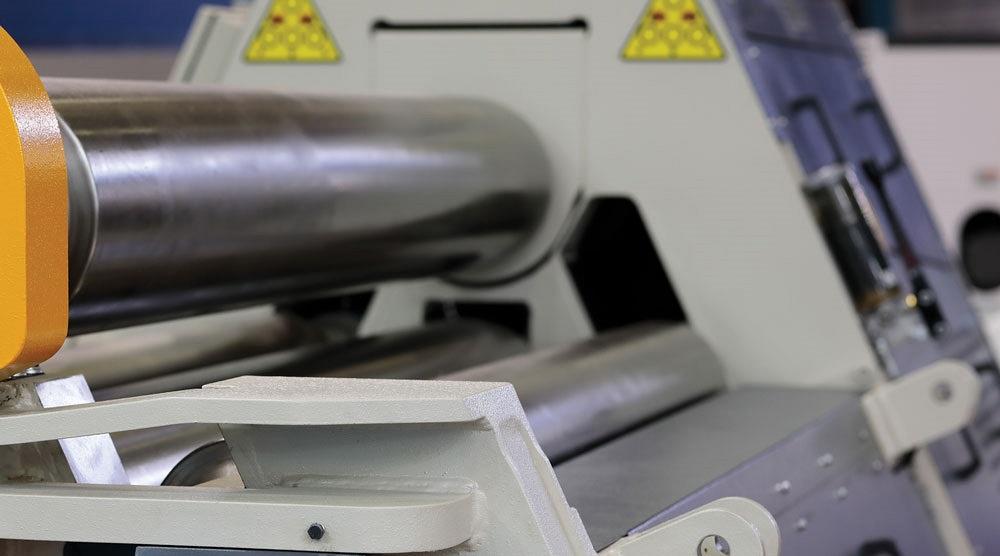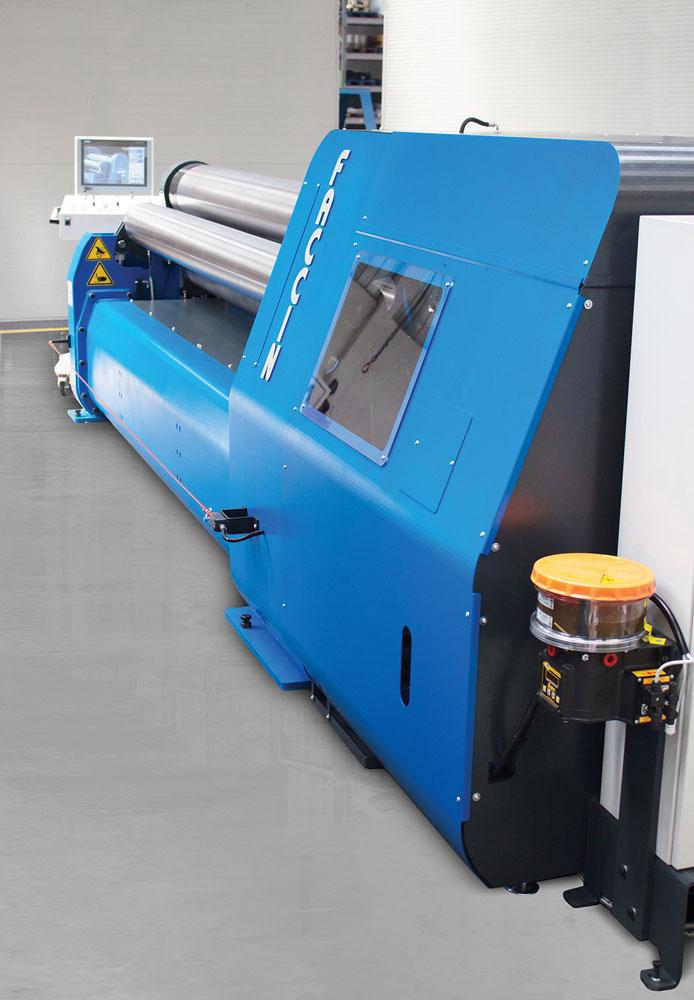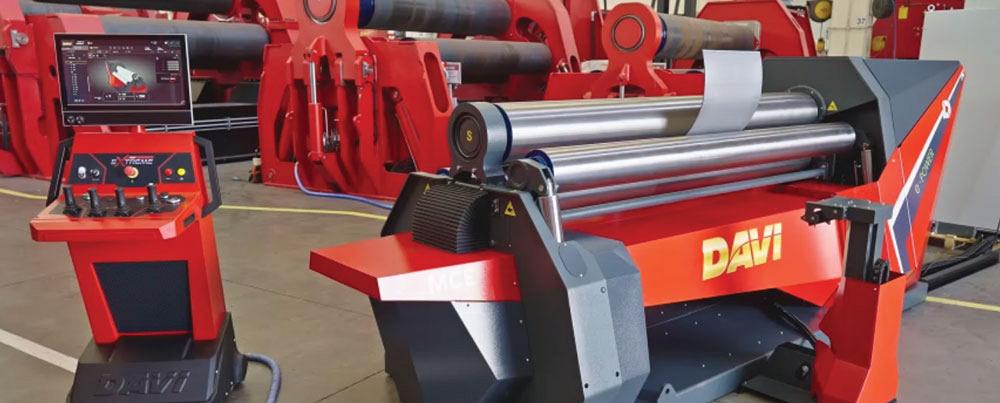Associate Editor
- FMA
- The Fabricator
- FABTECH
- Canadian Metalworking
The evolution of plate rollers
Hydraulic, hybrid, and electric plate rollers all have a place on the shop floor
- By Lindsay Luminoso
- January 26, 2024
- Article
- Fabricating

A hydraulic plate roller’s upfront cost makes it more accessible for fabricators, especially those with low-volume, high-mix production, where this style of plate roller is a good fit. genkur/iStock/Getty Images Plus
When it comes to plate rollers, the technology is moving, like much of the industry, towards electrification. Today, fabricators can choose from many different types and models of plate rollers, including fully hydraulic, hybrid, and fully electric options. Understanding the benefits and limitations of the options will make it easier to determine the best choice for shop operations.
Expanded Range of Hydraulics
While mechanical machines were the earliest designs, hydraulic plate rollers are a tried-and-true option with a decades-long standing in plate processing.
Cost. For the most part, hydraulic plate rollers are the least expensive of the options on the market and offer a standard speed of approximately 20 ft. per minute (FPM).
“A standard hydraulic roller will cost on average 25 to 30 per cent less than a fully electric option in the same size range,” said Steve Bonnay, regional manager (Canada) and special projects, DAVI Inc.
This upfront cost may make it more accessible for fabricators, especially for those with low-volume, high-mix production, where a hydraulic plate roller is a good fit.
Plate Thickness Range. Hydraulic machines are well suited for rolling plate that is 1.5 in. thick or more. This is mainly because thick plate tends to have some thickness variation, limiting the overall part accuracy that can be achieved.
“When we get into the thicker-plate machines, hydraulic currently is the way to go,” said Bonnay. “Most hydraulic machines offer a 0.004-in. accuracy, which in many cases is more accurate than the plate itself.”
When A Hybrid Make Sense
In recent years, many plate rolling equipment manufacturers have moved towards offering hybrid models, which provide some benefits over fully hydraulic options. The hybrid models combine the best of both options—the bending rolls are hydraulic but the rotating top roll is electric.
Cost. If one of the advantages of a hydraulic machine is its lower upfront cost compared to a fully electric machine, some manufacturers have found a happy medium with a hybrid machine.
“The price of our hybrid model is at a level comparable to that of the hydraulic model for the past three years,” said Andrea Comparin, senior technical specialist and head of sales for Americas, Faccin Group.

The Faccin 4HEP-E is a four-roll, direct electric-drive plate roller that integrates the hydraulic movement of the bending rolls with the electric rotation of the top roll. The introduction of electric rotation for the upper rolls provides energy savings and promotes environmental sustainability. Faccin
Speed. Today’s hybrid models can reach speeds of approximately 30 FPM, similar to their electric plate roller counterparts. This additional speed can reduce the overall cost per part.
Noise. Hybrid plate rollers can achieve silent operations by reducing the noise levels by almost 15 dB, a feature that also is found on fully electric models.
Maintenance. Because a hybrid system includes both electric and hydraulic components, having a centralized lubrication system is essential for reducing costs associated with maintenance.
“A hybrid plate roller’s hydraulic system needs a smaller tank, approximately a reduction of 70 per cent of oil volume, fewer valves and hoses, and fewer components, which in turn frees up more space for maintenance activities,” said Comparin. “This type of system reduces the need for frequent oil replacement. As a result, the amount of oil that needs to be disposed of is significantly decreased, providing additional benefits.”
Electrification of Plate Rollers
One of the biggest reasons why a company would choose a fully electric plate roller is similar to why it would choose an electric press brake: it provides high accuracy, high speeds, and significantly less maintenance than other options. And while an electric plate roller’s upfront cost is typically 30 per cent higher than a hydraulic machine, the benefits it offers might offset this initial price point, resulting in a faster return on investment.
Accuracy. While a hydraulic plate roller’s accuracy is 0.004 in., an electric plate roller’s accuracy is 0.0025 and 0.0015 in.
“It can be twice, or a little bit better than twice, as accurate,” said Bonnay. “When you get into thicker plate, because the plate becomes less accurate, the accuracy of the machine becomes less significant. This means that, while you may be able to get an electric plate roller in any size, it is best suited for anything in the 1.5- to 2-in. plate thickness range or less.”
Speed. While the standard speed of a hydraulic system is roughly 20 FPM, a fully electric model can reach upwards of 32 FPM.
“Right out of the gate, it is 30 per cent faster,” said Bonnay. “This is especially important for OEM and production-type work where reducing cycle time is essential, and it can work in a job shop if there is enough work to warrant it.”
Maintenance. One of the big advantages of a fully electric plate roller is that there are no valves, hydraulic hoses, or anything of that nature to deal with.

DAVI e-POWER's simultaneous movement across multiple axes allows it to execute multiple tasks concurrently, overcoming limitations of traditional methods for efficient workflow and high output. DAVI
“Most often when a service team gets a call and the machine is not working, it's not the joystick, PLC, or encoder,” said Bonnay. “Nine times out of 10, a valve is stuck, there is debris in hydraulic hoses, or a seal on a cylinder is leaking and not developing enough pressure. More often than not, the problem is hydraulic in nature. With electric, that is not that case.”
If there’s an inverter issue, it’s fairly easy to troubleshoot and get back up and running.
Operating Cost. With a hydraulic machine, the electric motor is always spinning. Even if its not pushing fluid, that motor is still drawing power.
“When an electric machine is on but sitting idle, the only thing that is drawing some amount of power is the computer screen,” said Bonnay. “With the cost of electricity rising, many fabricators are focused on energy efficiency, and this machine can help with that. With an electric machine, fabricators will see about 25 to 35 per cent or less power consumption in an average day. As electricity bills go up, the percentage will stay the same, but the savings will increase. In the next five years, from a unit perspective, we anticipate that electric machines will make up 60 per cent of our plate roll business. This is directly related to the fact that businesses are focused on energy efficiency.”
Complex Parts Production. An electric plate roller makes a lot of sense for fabricators looking to either do a lot of multiple radii, where they want to blend from one radius to another, or in situations where robotic welding downstream is needed.
“Robots are poor at adjusting to production variations,” said Bonnay. “If there is a 0.125-in. gap where welding is required, a human welder can adjust. A robot will not know what to do and will rely on a program that maybe doesn’t have that gap featured in it. An electric plate roller will be especially helpful in these applications.”
Associate Editor Lindsay Luminoso can be reached at lluminoso@fmamfg.org.
DAVI, www.davi.com
Faccin Group, www.faccingroup.com
About the Author

Lindsay Luminoso
1154 Warden Avenue
Toronto, M1R 0A1 Canada
Lindsay Luminoso, associate editor, contributes to both Canadian Metalworking and Canadian Fabricating & Welding. She worked as an associate editor/web editor, at Canadian Metalworking from 2014-2016 and was most recently an associate editor at Design Engineering.
Luminoso has a bachelor of arts from Carleton University, a bachelor of education from Ottawa University, and a graduate certificate in book, magazine, and digital publishing from Centennial College.
subscribe now


Keep up to date with the latest news, events, and technology for all things metal from our pair of monthly magazines written specifically for Canadian manufacturers!
Start Your Free Subscription- Trending Articles
Aluminum MIG welding wire upgraded with a proprietary and patented surface treatment technology

Achieving success with mechanized plasma cutting

Hypertherm Associates partners with Rapyuta Robotics

Gema welcomes controller

Brushless copper tubing cutter adjusts to ODs up to 2-1/8 in.

- Industry Events
MME Winnipeg
- April 30, 2024
- Winnipeg, ON Canada
CTMA Economic Uncertainty: Helping You Navigate Windsor Seminar
- April 30, 2024
- Windsor, ON Canada
CTMA Economic Uncertainty: Helping You Navigate Kitchener Seminar
- May 2, 2024
- Kitchener, ON Canada
Automate 2024
- May 6 - 9, 2024
- Chicago, IL
ANCA Open House
- May 7 - 8, 2024
- Wixom, MI















